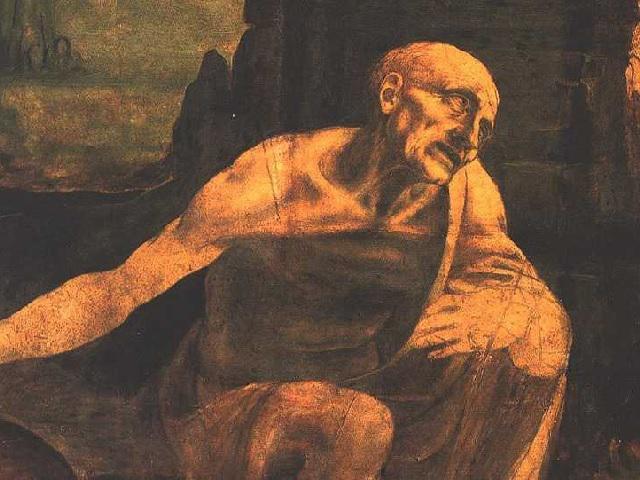St Geronimo

Leonardo da Vinci's painting of Saint Jerome in the desert, created in 1480, is a masterpiece that showcases the artist's incredible talent and attention to detail. The painting, which is currently housed in the Vatican, is a captivating portrayal of the saint in a moment of deep contemplation and penance. The central figure of Saint Jerome is depicted with a strikingly dramatic posture, his face conveying a sense of both suffering and spirituality. Leonardo's skillful use of light and shadow adds depth and emotion to the scene, drawing the viewer into the saint's inner turmoil.
One of the most notable features of the painting is the presence of a large lion, symbolizing Saint Jerome's connection to the wilderness and his struggle against his own inner demons. The lion's body and tail form a double spiral along the base of the painting, adding a sense of movement and energy to the composition. In the background, a rugged landscape of steep rocks and sharp peaks creates a stark contrast to the saint's contemplative pose, adding a sense of mystery and awe to the scene.
As the viewer's gaze moves across the painting, they are drawn to a classical architecture in the upper right corner, a subtle reminder of the saint's connection to the church and his dedication to his faith. The intricate details of the architecture, combined with the rugged beauty of the landscape, create a sense of harmony and balance in the composition. Leonardo's meticulous attention to detail is evident in every brushstroke, from the saint's expressive face to the intricate folds of his robes.
Overall, Leonardo da Vinci's painting of Saint Jerome in the desert is a powerful and evocative work of art that continues to captivate viewers with its beauty and complexity. As visitors to the Vatican gaze upon this masterpiece, they are transported to a moment of spiritual reflection and contemplation, experiencing the timeless beauty of Leonardo's vision and the enduring power of Saint Jerome's story.
© ChatGPT 3.5
*This work is one of the momentous commissions that Leonardo received in 1480, although he never finished it, possibly due to his departure to Milan.
*It is one of Da Vinci's most enigmatic works.
*It appears in the inventory of assets inherited by Salai, Italian Renaissance painter, disciple and assistant of Leonardo.
*Later it passed into the hands of the Swiss painter Angelica Kauffman in Rome. After Kauffman's death the panel was lost and some time later it was found by chance and acquired by Napoleon's uncle, Cardinal Joseph Fesch.
*It is said that Fesch found the board split in two, the upper part in the possession of a shoemaker who used it as a bench surface and the lower part as a chest. The work was severely damaged, and even part of it was apparently used as a table before being rescued and, to a certain extent, restored.
*After the cardinal's death, the painting was auctioned and sold several times, until it was recognized and acquired by Pius IX for the Vatican Pinacoteca (1856)